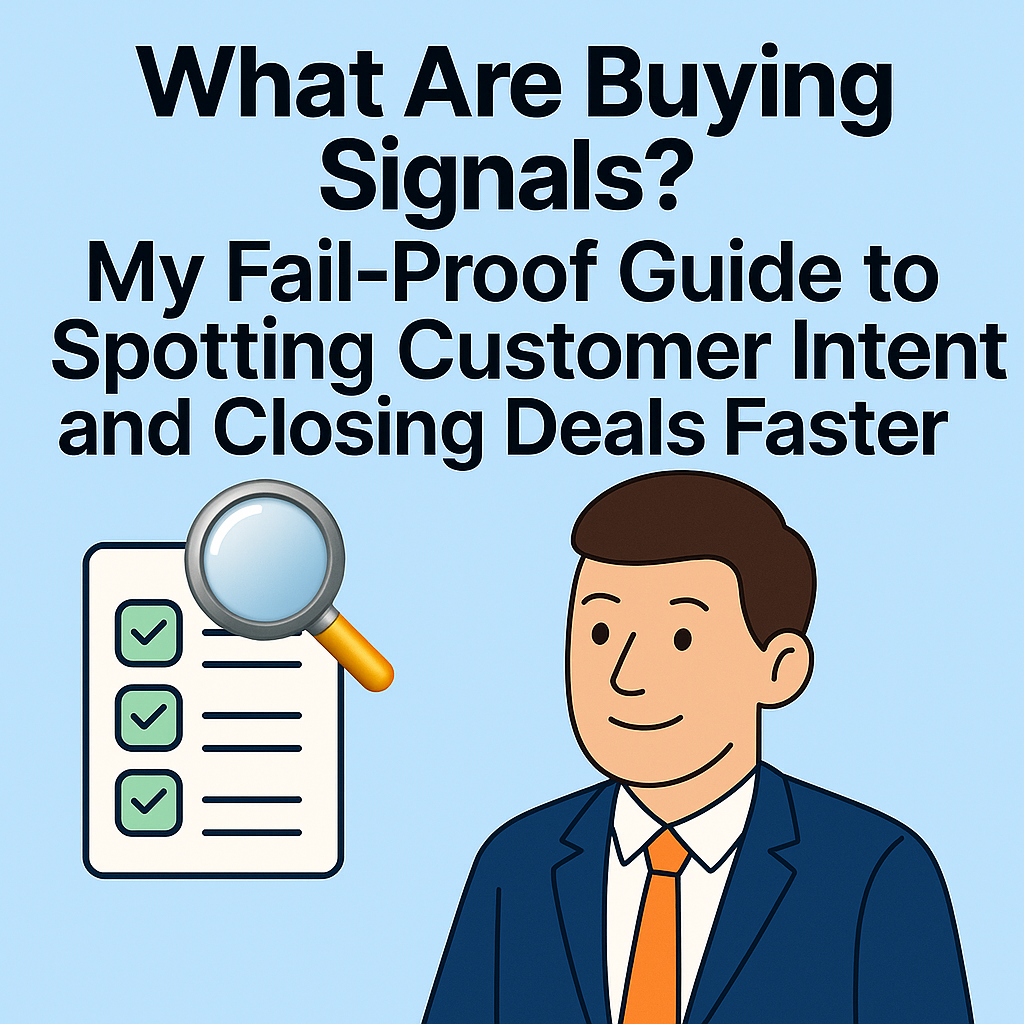Burnout to Pipeline: 12 Best AI Tools for Sales That Work
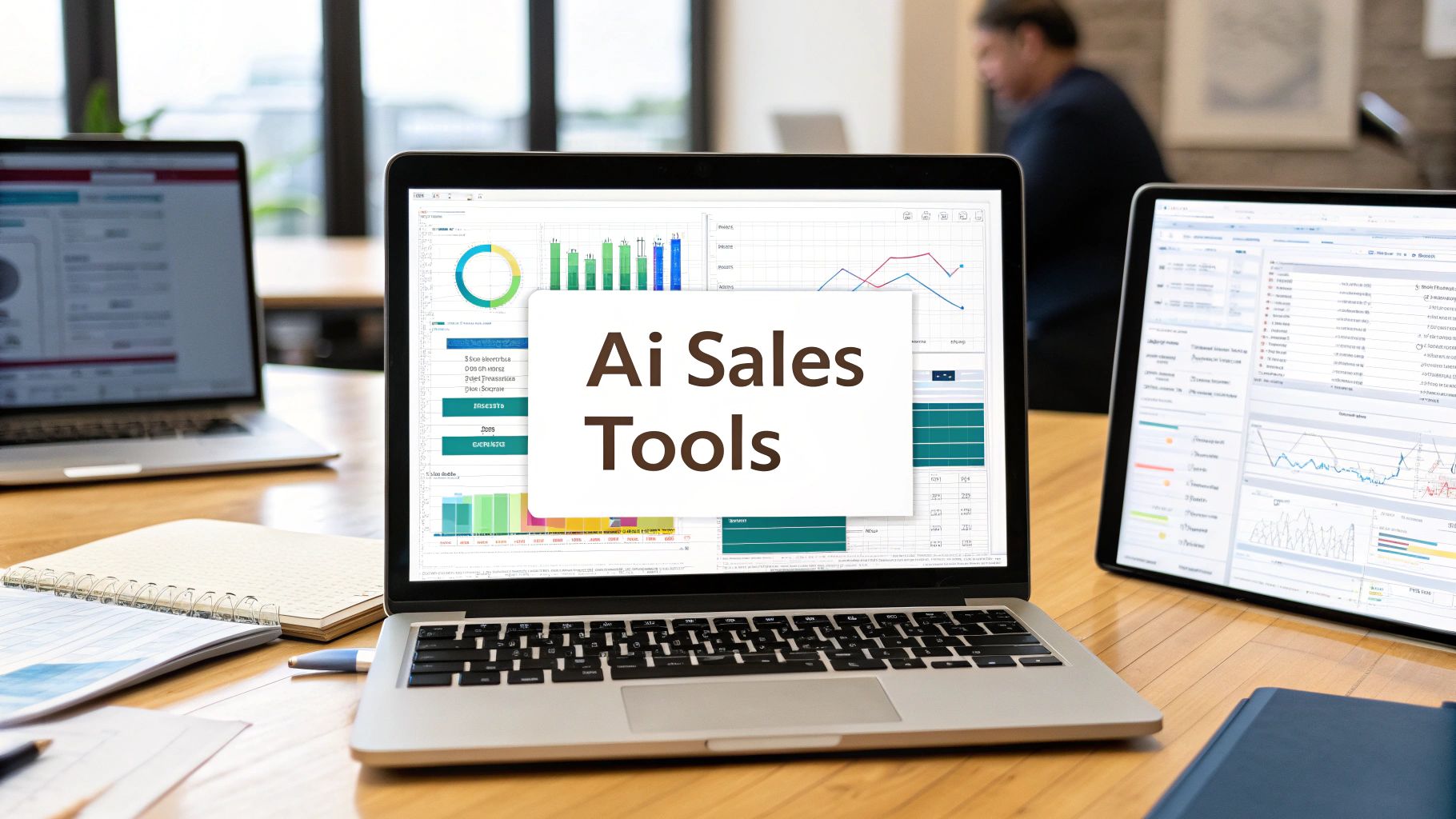
Let's be real for a second. How much of your day is spent on soul-crushing prospecting that goes nowhere? I’ve been there.
I recall one particularly brutal quarter, in which I sent over 2,000 cold emails and booked maybe five meetings. My pipeline was a ghost town, and my morale was even lower. I was doing everything by the book, but the book was outdated. I almost burned out completely before I had my 'aha!' moment: I wasn't working smarter, just harder.
The game changed when I stopped treating sales like a numbers game of brute force and started treating it like a strategy game, with AI as my secret weapon.
So, what if you could stop guessing and start knowing exactly who to talk to and when? This isn't just another list of shiny new toys; it's a battle-tested arsenal. These are the best AI tools for sales that transformed my process from a high-effort grind into a high-impact growth engine.
They automate the tedious tasks, deliver laser-focused insights, and help you close deals faster. Forget wasting hours on dead-end leads and manual data entry.
In this comprehensive guide, we'll dive deep into the top platforms that will supercharge your sales strategy. For each tool, I’ll give you the real-world breakdown you need to make an informed choice:
- Honest Pros & Cons: No marketing fluff, just what works and what doesn't.
- Practical Use Cases: Concrete examples of how to apply each tool for maximum impact.
- Pricing & Implementation: A proper insight into the investment required.
I've included direct links and screenshots for every tool, so you can see exactly how they function. Get ready, because we're about to rebuild your pipeline. 🚀
1. Gojiberry AI
Best For: Automated High-Intent Lead Generation
Let me tell you a secret: Gojiberry AI is at the top spot because it solves the single biggest problem I had for years, talking to people who weren't ready to buy. It fundamentally changes the nature of the lead generation game. Instead of you chasing leads, it brings the warmest, most sales-ready prospects directly to your doorstep.
Ever felt like you're just throwing spaghetti at the wall with cold outreach? I've been there, spending weeks building lists that go nowhere. Gojiberry AI is the antidote to that wasted effort, acting as your 24/7 scout on LinkedIn to find leads who are practically raising their hands to buy. It's one of the best AI tools for sales because it shifts your team’s focus from finding leads to closing them.
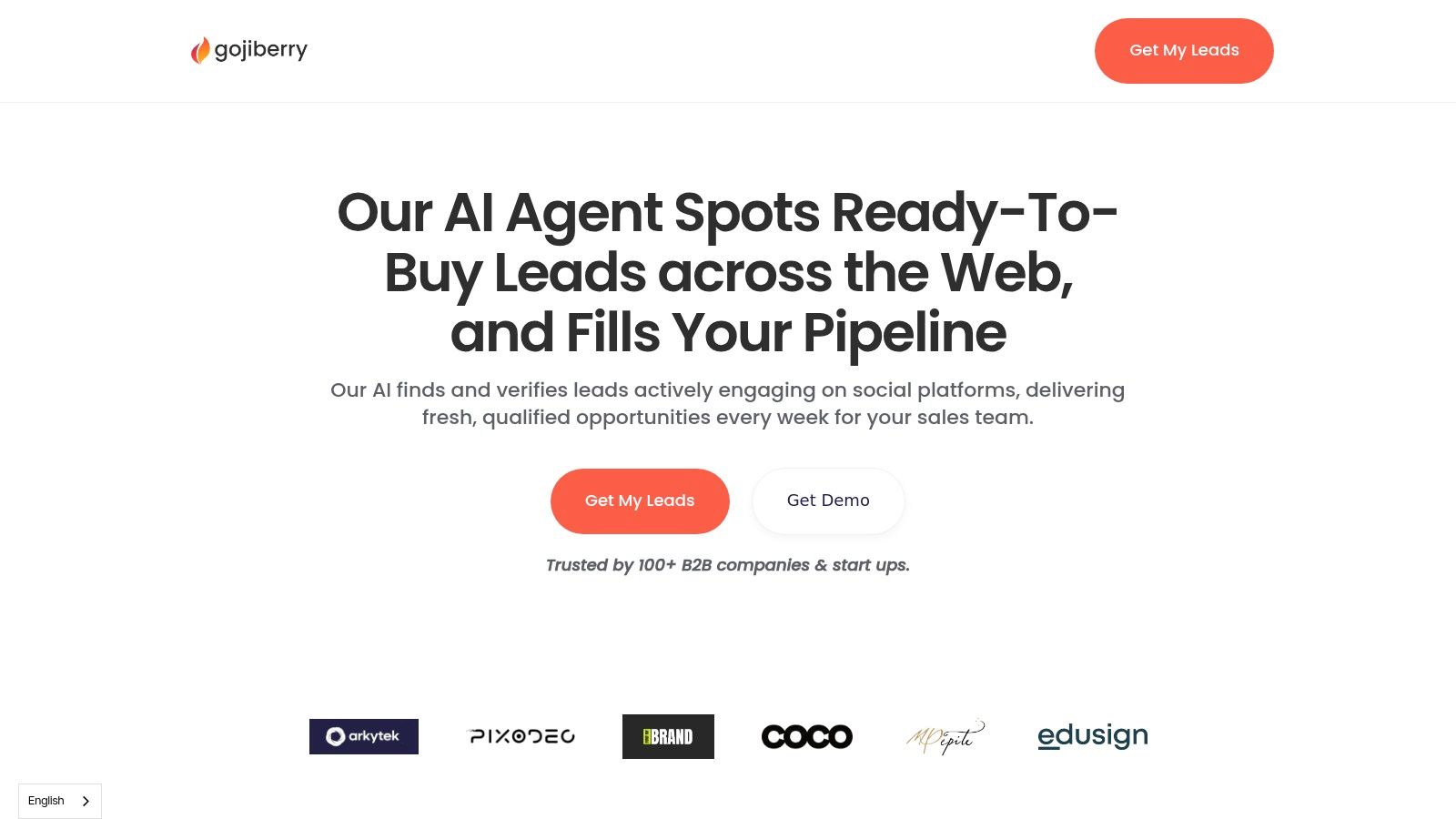
This platform excels by monitoring critical buying intent signals in real-time. It doesn't just scrape names; its AI analyzes job changes, follows of your competitors, and engagement with keywords relevant to your solution. The result? A daily feed of prospects who are actively in-market, delivered with verified contact details right into your CRM or a dedicated Slack channel. This isn't just a list; it’s a curated pipeline of opportunity.
Why Gojiberry AI Stands Out
What truly sets Gojiberry AI apart is its laser focus on buying intent. While other tools provide massive, unfiltered lists, Gojiberry AI prioritizes quality over quantity. Think of it this way: would you rather have 1,000 cold names or 10 warm leads who just started following your biggest competitor and posted about needing a new solution? This precision saves countless hours and dramatically increases conversion rates.
Key Insight: "We saw our meeting booking rates triple within the first month. Instead of our reps spending 80% of their time prospecting, they now spend that time in demos with people who actually want to talk. It completely changed our sales motion." - A GojiberryAI User Testimonial.
How to Use Gojiberry AI Effectively: A Quick Guide
- Don't Do This: Don't just set up generic keywords. That’s a rookie mistake. The power is in specificity. Instead of "SaaS," use terms like "revenue operations platform" or "customer success software."
- Do This: Integrate it directly with your primary communication channel, like Slack. This creates an immediate workflow where new, hot leads are instantly visible to the team, allowing for follow-up in minutes, not hours. Speed is everything.
- Actionable Tip: Create a dedicated sequence in your outreach tool specifically for Gojiberry AI leads. Your opening line can be highly contextual, like, "Saw you recently followed [Competitor], and I thought you might be interested in how we compare on [specific feature]." This personalization is a game-changer.
Pros & Cons
- Pros:
- Delivers highly qualified, warm leads based on real-time buying intent.
- Saves significant time by automating lead discovery and verification.
- Provides enriched and verified contact information (email, phone, LinkedIn).
- Proven ROI with testimonials citing 6x returns and booked calendars.
- Ideal for B2B companies, startups, and founders needing to scale quickly.
- Pricing is not public; you must contact them for a quote.
- Heavily reliant on LinkedIn, which may be less effective for industries with low platform engagement.
Website: https://gojiberry.ai
2. Salesforce Sales Cloud
Salesforce is the undisputed titan of CRM, and its Sales Cloud with Einstein AI is its heavyweight champion in the AI sales arena. If you’re already in the Salesforce ecosystem, integrating Einstein feels less like adopting a new tool and more like unlocking a superpower you didn’t know you had. It’s not just about automating tasks; it’s about making your entire sales process smarter. Think of it as having a data scientist whispering in your ear, telling you which lead to call next and what deal is most likely to close this quarter.
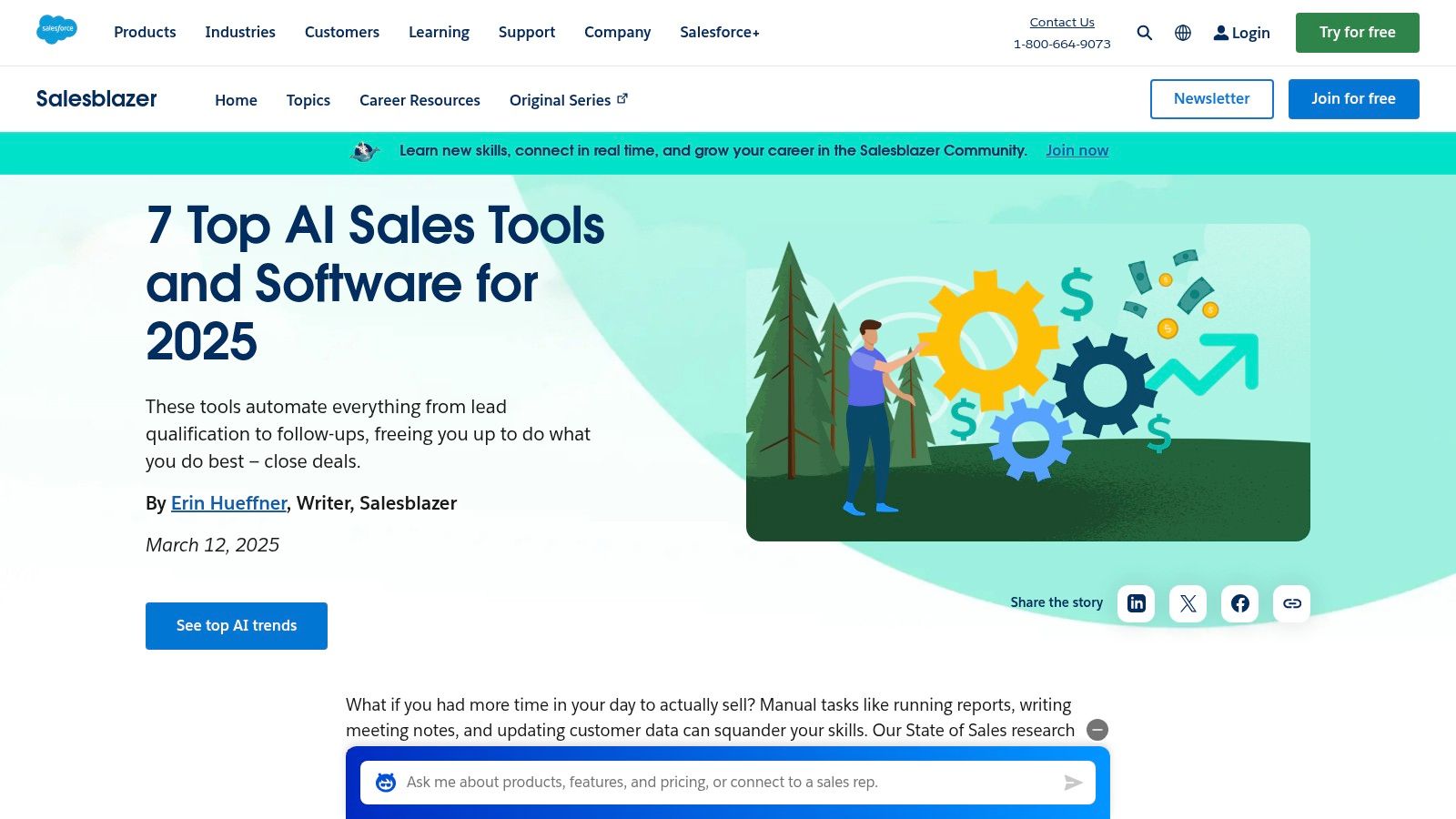
The Einstein AI layer analyzes all your historical data, every won deal, lost opportunity, and customer interaction to provide shockingly accurate predictions. It goes beyond simple data entry and helps your team prioritize with surgical precision, ensuring they focus their energy where it counts the most. This is one of the best AI tools for sales because it embeds intelligence directly into the workflow your team already uses
My Experience & Actionable Tips
I’ve seen teams get bogged down in Salesforce, treating it like a glorified Rolodex. The biggest mistake you can make is ignoring Einstein. Turn on Predictive Lead Scoring immediately. Don't let your reps waste time on cold leads when AI can flag the ones showing real buying signals.
Actionable Tip: Create a custom dashboard that combines Einstein's Opportunity Scoring with your sales activity metrics, which reports the real-time view of your pipeline's health and helps you spot at-risk deals before it's too late. It’s a game-changer for forecast accuracy.
What to NEVER do: Don't buy Salesforce just for the AI. The real power comes from its deep integration with the core CRM. If your data hygiene is poor, Einstein’s predictions will be, too. Garbage in, garbage out. Clean your data first!
Pros:
- Deep CRM Integration: Seamlessly works within the platform your team likely already lives in.
- Highly Customizable: Can be tailored to fit complex and unique business processes.
- Robust Analytics: Offers powerful reporting that can transform sales strategy.
Cons:
- High Cost: Can be prohibitively expensive, especially for smaller businesses or startups.
- Steep Learning Curve: Requires significant training and a dedicated admin to get the most out of it.
Pricing: Salesforce Sales Cloud pricing starts at $25/user/month (billed annually) for the Starter edition. However, the powerful Einstein AI features are primarily included in higher-tier plans, such as Unlimited ($330/user/month) or by purchasing the Sales Cloud Einstein add-on, which has its own pricing structure.
Website: https://www.salesforce.com/sales/artificial-intelligence/ai-sales-tools/
3. Gong.io
Gong isn't just a call recorder; it's a reality engine for your sales team. It sits in on every call, demo, and meeting, using AI to analyze what was said, how it was said, and what it means for your pipeline. Have you ever wished you could clone your top-performing rep? Gong essentially does that by dissecting their successful conversations and turning them into a playbook for your entire team. It exposes the unfiltered truth of your customer interactions, moving you from guesswork to data-backed strategy.
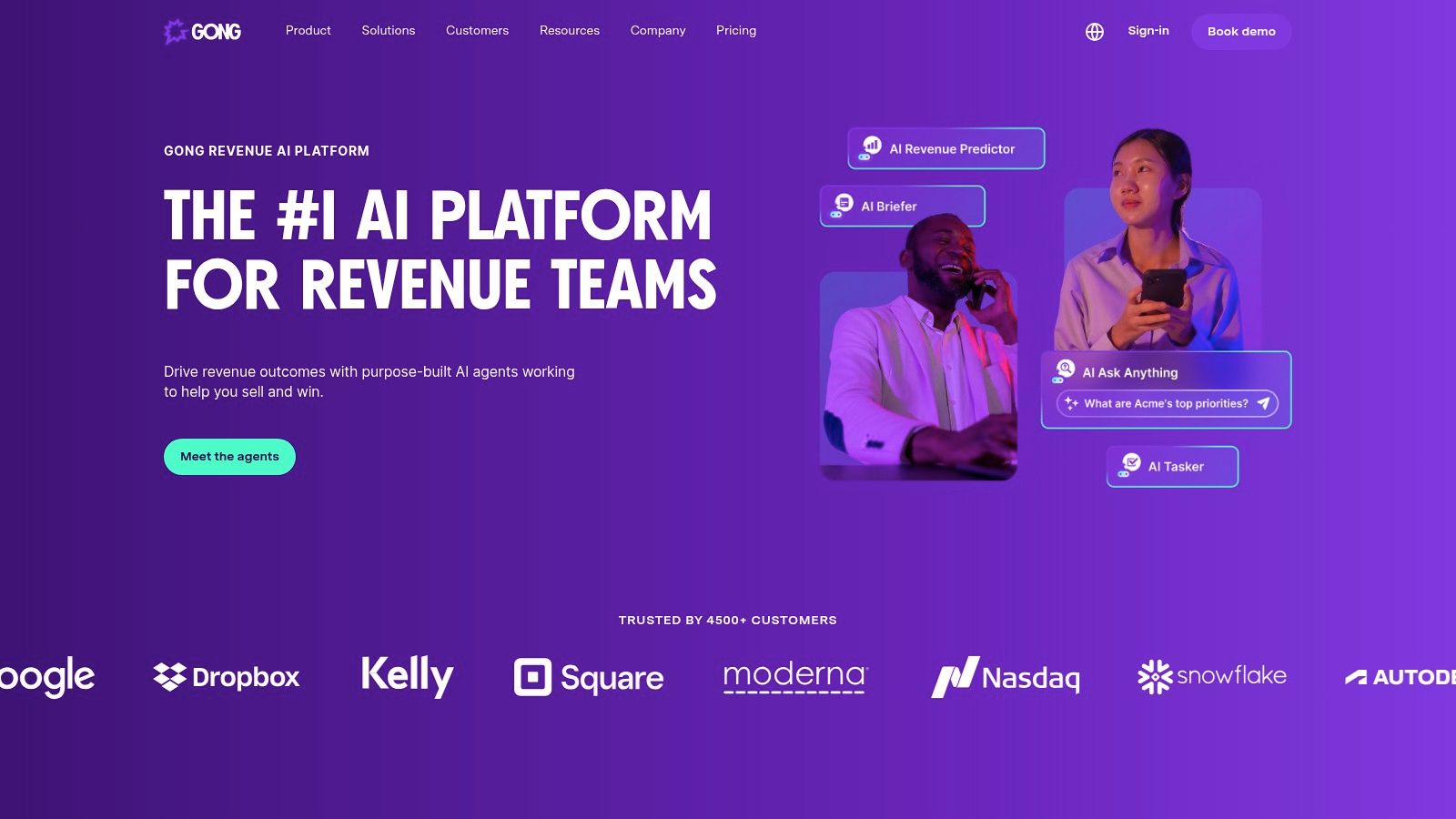
The platform’s revenue intelligence captures and analyzes every interaction, providing insights that would otherwise be lost forever. It flags deal risks, identifies key topics, and automatically tracks competitor mentions. This makes it one of the best AI tools for sales because it transforms coaching from a subjective art into an objective science, directly impacting quota attainment and forecast accuracy. You can master the sales follow-up call by leveraging the insights from these recordings.
My Experience & Actionable Tips
I’ve seen sales managers give vague feedback such as "be more consultative." It's useless. With Gong, a manager can say, "I noticed our top reps have a 45:55 talk-to-listen ratio, and yours is 70:30. Let's work on asking more open-ended questions." It’s a complete paradigm shift.
Actionable Tip: Create a "Best Practices" library in Gong. When a representative achieves a difficult objective or delivers a killer value proposition, record that moment and add it to the library. During onboarding or weekly training, have the team review these real-world examples. It's infinitely more powerful than role-playing.
What to NEVER do: Don't use Gong as a "gotcha" tool to micromanage your reps. Its purpose is to coach and improve, not to create a culture of fear. If your team thinks Big Brother is watching, they’ll clam up, and the quality of insights will plummet. Frame it as a development tool from day one.
Pros:
- Actionable Coaching: Provides concrete, data-driven feedback to improve rep performance.
- Enhanced Forecasting: Improves pipeline visibility and forecast accuracy significantly.
- Strong CRM Integration: Works well with Salesforce and other CRMs to enrich deal data.
Cons:
- Opaque Pricing: You must contact sales for a custom quote, which can be a hurdle for planning.
- Requires Cultural Buy-in: Its effectiveness depends on the team embracing it for coaching, not surveillance.
Pricing: Gong.io does not publish its pricing. It’s based on the number of users and the specific platform configuration you require. You will need to contact their sales team for a personalized quote.
Website: https://www.gong.io/
4. Outreach
Outreach is the go-to platform for sales teams who want to execute their outreach strategy with ruthless efficiency and intelligence. It’s not just an email blaster; it’s a full-on sales engagement engine that uses AI to make sure your reps are talking to the right people, with the right message, at the right time. Think of it as your team's command center, orchestrating every touchpoint from emails and calls to social media interactions, all while learning what works.
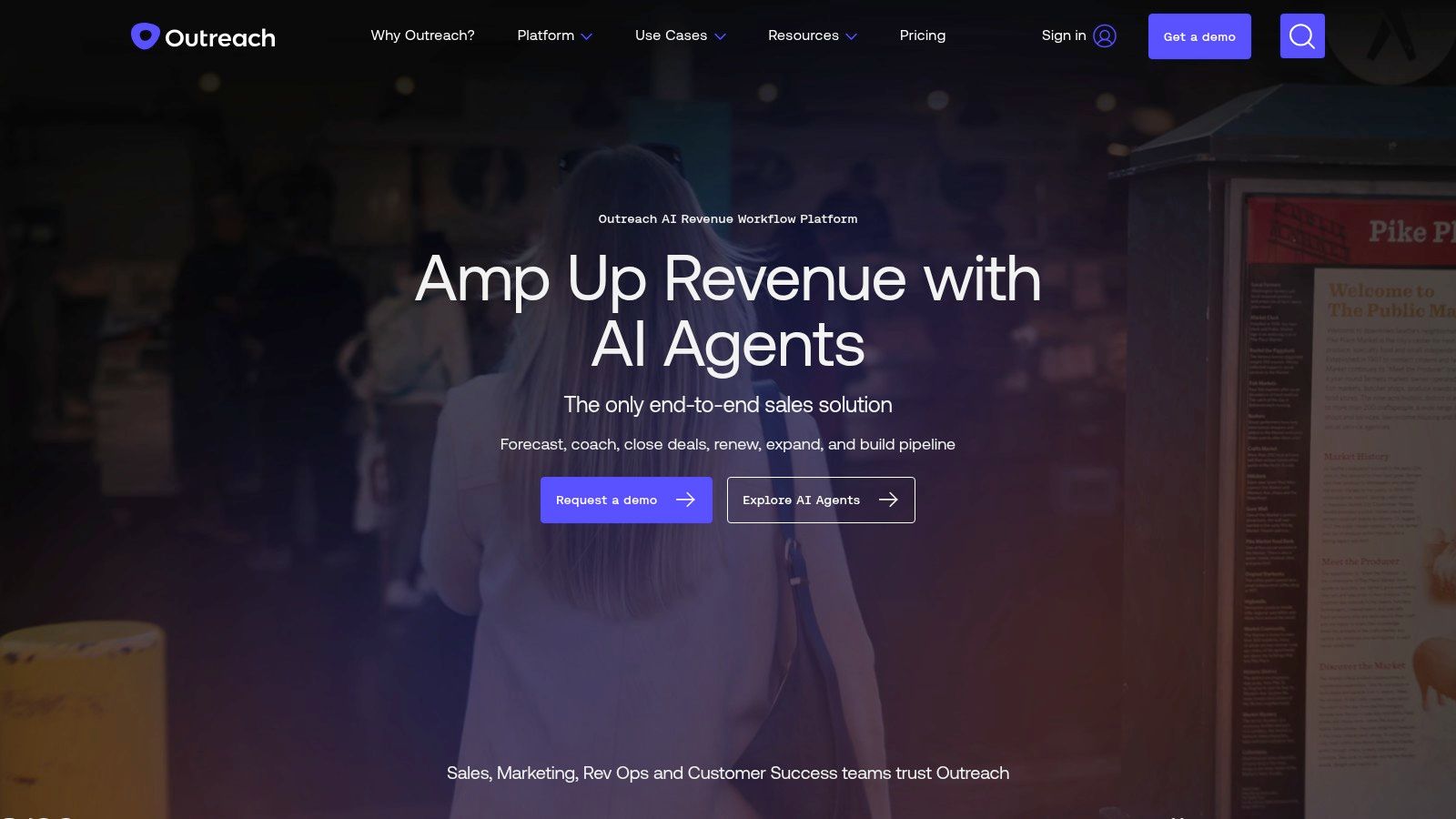
The platform’s AI, named "Kaia" (Knowledge AI), helps reps not just with what to say, but how to say it. It analyzes millions of data points to optimize email subject lines, body content, and sending times. This turns outreach from a guessing game into a data-driven science, making it one of the best AI tools for sales when considering boosting reply rates and booking more meetings. It’s about making every single interaction count.
My Experience & Actionable Tips
I’ve seen teams adopt Outreach and immediately get lost in building overly complex, 50-step sequences. Start simple. The real magic isn't the number of steps; it's the quality of the engagement.
Actionable Tip: Utilize the A/B testing feature on your email templates from day one. Test one variable at a time, like the subject line or the call-to-action. Let the AI gather data for a week, then double down on the winner. This simple habit can boost your reply rates significantly within a month.
Don't do this: Don't let your reps run on autopilot. Outreach makes automation easy, but it can lead to robotic, impersonal messages. Insist that your team personalizes at least the first two sentences of every "Step 1" email. The AI provides the template; the human provides the soul.
Pros:
- Boosts Team Efficiency: Automates repetitive tasks, allowing reps to focus on selling.
- Actionable Insights: Provides clear data on what engagement strategies are working.
- Seamless CRM Integration: Works perfectly with Salesforce and other CRMs to keep data in sync.
Cons:
- High Cost: Can be a significant investment, especially for smaller businesses.
- Learning Curve: Requires proper setup and training to unlock its full potential.
Pricing: Outreach does not list its pricing publicly. It is quote-based and tailored to the size of your team and the specific features you need. Expect it to be a premium-priced solution aimed at mid-market and enterprise companies.
Website: https://www.outreach.io/
5. Apollo.io
Apollo.io has become the go-to workhorse for startups and lean sales teams, and for good reason. It’s less of a pure AI tool and more of an all-in-one sales intelligence and engagement platform supercharged with AI features. Think of it as the Swiss Army knife for prospecting: you get a massive B2B database, an email finder, and an outreach sequencer all under one roof. For teams that can’t afford separate tools for data, verification, and outreach, Apollo is a lifesaver.
The platform primarily uses AI for data enrichment and identifying ideal customer profiles, but its real power is in consolidating the top-of-funnel workflow. Instead of jumping between a data provider, a verification tool, and an email sender, your reps can do it all in one place. This makes it one of the best AI tools for sales, not because of groundbreaking AI, but because it streamlines the entire prospecting process so efficiently.
My Experience & Actionable Tips
I’ve seen countless startups get their first 100 customers using Apollo. The biggest win is the sheer value it provides. Where else can you get millions of contacts and a sequencing tool for this price? The data isn't always perfect, but it's more than good enough to get started.
Actionable Tip: Use the "Buying Intent" filters to find companies actively researching solutions like yours. Combine this with job change alerts. When a past champion of your product moves to a new company, Apollo can flag it, providing you with the warmest possible intro. It’s a prospecting goldmine.
What to NEVER do: Don't just export a list and blast everyone. That’s a fast track to getting your domain blacklisted. Use the built-in A/B testing for your email sequences. Test your subject lines and call-to-actions relentlessly to see what resonates, but be aware of their limitations. So if you're looking for alternatives, you can find a comprehensive breakdown of Apollo.io alternatives here.
Pros:
- All-in-One Platform: Combines data, engagement, and intelligence, reducing the tool costs.
- Affordable Pricing: Offers a generous free plan and cost-effective paid tiers for growing teams.
- User-Friendly Interface: Easy to learn and implement, especially for teams new to sales tech.
Cons:
- Data Accuracy Can Vary: While vast, the contact data isn't always 100% accurate; verification is key.
- Basic Automation: The sequencing features are solid, but less advanced than dedicated outreach platforms.
Pricing: Apollo.io has a popular free plan that includes 60 mobile and 120 export credits per year. Paid plans start at $49/user/month (billed annually), offering more credits and advanced features.
Website: https://www.apollo.io/
6. ZoomInfo SalesOS
If your sales team is flying blind, ZoomInfo SalesOS is the AI-powered radar system you desperately need. It’s less about telling you how to sell and more about ensuring you’re selling the right people with laser-accurate contact and company data. Think of it as the ultimate cheat sheet for B2B prospecting, powered by an AI engine that constantly verifies and enriches its massive database. It turns the cold, vast market into a warm, manageable list of high-potential leads.
ZoomInfo's strength lies in its AI-driven data collection and Intent signals. It doesn't just give you a name and a number; it tells you which companies are actively researching solutions like yours right now. This shifts the prospecting game from "Who should I call?" to "Who is ready to buy?" For any B2B team, this is one of the best AI tools for sales because it fills the top of your funnel with quality, not just quantity.
My Experience & Actionable Tips
I’ve seen reps spend half their day searching for the correct contact info on LinkedIn, only to have their emails bounce. ZoomInfo kills that wasted time. The first step is to integrate it with your CRM. This creates a two-way street where your CRM records are enriched with fresh data, and your reps can prospect directly from their native environment.
Actionable Tip: Don't just search for job titles; use the Intent-based prospecting filters to find companies searching for your competitors or relevant keywords. Create a saved search for these high-intent accounts and set up alerts. It’s like having a scout that tells you exactly when to engage an account.
What to NEVER do: Don't rely on it as your only sales tool. ZoomInfo is phenomenal for data and prospecting, but it won’t write your emails or manage your deals. Combine its powerful data with a sales engagement tool for maximum impact. Trying to use it for everything is like using a screwdriver to hammer a nail. 🔨
Pros:
- High-quality, accurate contact data: Widely considered the gold standard for B2B data accuracy.
- Enhances sales and marketing alignment: Both teams can work from the same rich dataset and intent signals.
- Improves outreach efficiency: It quickens the time spent on manual research and data validation.
Cons:
- Pricing details are not publicly listed: It requires a conversation with sales, which can be a barrier for some.
- May require training to utilize all features effectively: There's a lot of power under the hood that isn't immediately obvious.
Pricing: ZoomInfo’s pricing is customized based on the number of licenses, data credits, and specific features you need. You'll need to contact their sales team for a custom quote, as they do not list standard pricing on their website.
Website: https://www.zoominfo.com/solutions/sales
7. LinkedIn Sales Navigator
LinkedIn Sales Navigator is where social selling gets its superpowers. In the B2B world, your buyers are already on LinkedIn, and Sales Navigator uses AI to help you find them, understand their needs, and engage them intelligently. It transforms the world’s largest professional network from a passive database into an active, AI-driven prospecting machine. It's less about cold outreach and more about building warm, informed relationships that lead to sales.
Think of it as your secret weapon for account-based marketing. The AI doesn’t just find people with a certain job title; it surfaces key decision-makers, recommends similar leads based on your past successes, and alerts you to critical buying signals like a contact changing jobs or their company being mentioned in the news. This is one of the best AI tools for sales because it leverages a unique, real-time dataset of professional activity that no other platform can match.
My Experience & Actionable Tips
I’ve seen too many reps use Sales Navigator as just a fancy search bar. That’s like buying a sports car to drive it to the grocery store only. The real magic is in the AI-powered recommendations and alerts. You have to let the platform work for you.
Actionable Tip: Build hyper-specific lead lists using the Advanced Search filters, then save them. The AI will learn from this and start sending you Lead Recommendations that are scarily accurate. Combine this with setting up real-time alerts for your target accounts. When a key executive posts something, you'll be the first to know and can engage authentically. This is a core tenet of effective B2B social selling. Want to dive deeper? Learn more about turning social media into a sales machine.
What to NEVER do: Don't send a generic InMail message right after connecting. The AI gives you the intel; use it! Mention a recent company achievement you saw in their feed or a shared connection. Personalization is everything, and ignoring the context Sales Navigator provides is a guaranteed way to get ignored.
Pros:
- Unparalleled Network Access: Direct line to LinkedIn’s massive and up-to-date professional database.
- CRM Integration: Syncs leads, accounts, and activities with major CRMs like Salesforce and HubSpot.
- Actionable Buying Signals: Provides timely insights that help you start relevant conversations.
Cons:
- Requires LinkedIn Savvy: Most effective when you're already active and have a solid profile.
- Limited InMail Credits: Your direct messaging capabilities are capped monthly, forcing you to be strategic.
Pricing: LinkedIn Sales Navigator has three main tiers: Core (around $99/user/month), Advanced (around $149/user/month), and Advanced Plus (custom pricing). Prices can vary, and an annual subscription often provides a discount.
Website: https://business.linkedin.com/sales-solutions/sales-navigator
8. Pipedrive
Pipedrive has earned its reputation as the sales CRM built by salespeople, for salespeople, and its AI features stay true to that ethos. It’s not about overwhelming you with complex data science; it's about providing smart, actionable nudges right where you need them. Think of it as a friendly, AI-powered sales manager that keeps your team on track, highlighting which deals need attention and what next steps are most likely to lead to a win. It’s designed to keep reps selling, not wrestling with the software.
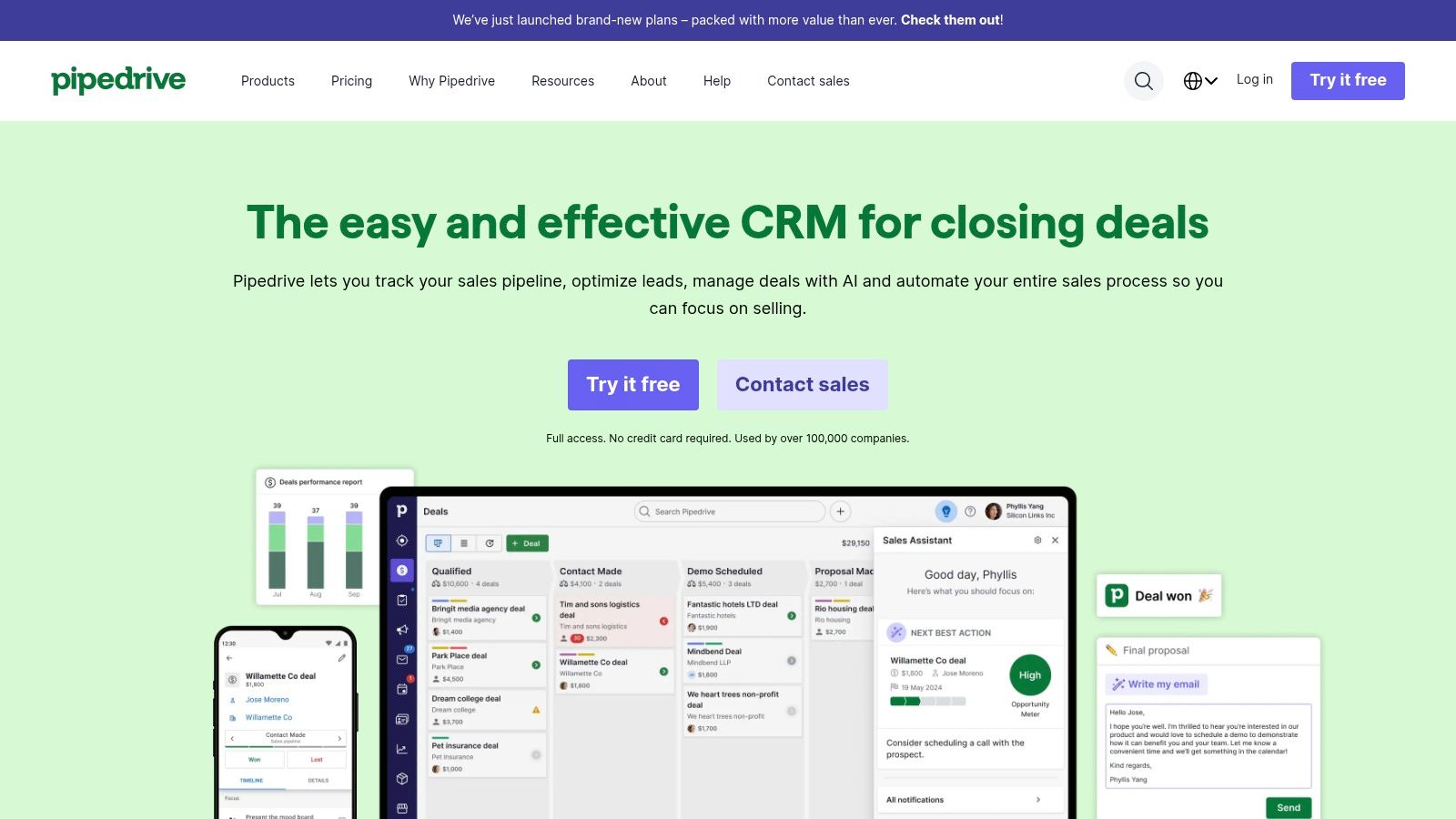
The platform's strength is its simplicity and visual pipeline management. Pipedrive’s AI Sales Assistant studies your past performance to suggest actions that will improve your win rate. It analyzes your data to find patterns you might miss, such as the optimal time to contact a lead or which activities consistently move deals forward. This makes it one of the best AI tools for sales for teams that need guidance without a steep learning curve.
My Experience & Actionable Tips
I've seen many smaller teams adopt Pipedrive and immediately feel more organized. The AI Sales Assistant is your best friend here, but it's only as good as the data you feed it. Consistency is everything.
Actionable Tip: Use the Automated Workflows to trigger tasks based on deal movement. For example, when a deal moves to the "Proposal Sent" stage, automatically create a task to follow up in three days. This trains both your team and the AI on your ideal sales process, leading to better AI-driven suggestions over time.
NEVER do this: Don't neglect the "Rotting" feature. The AI is great at flagging deals that have gone stale, but it's useless if you ignore the warnings. Treat every rotting deal notification as an urgent prompt. Either re-engage the prospect immediately or qualify them out so your pipeline stays clean and your forecasts are accurate.
Pros:
- User-friendly Interface: Incredibly intuitive and easy to set up, perfect for teams without a dedicated Admin.
- Affordable Pricing: Offers a great balance of features and cost for small to mid-sized businesses.
- Effective Automation: Simple yet powerful workflow automation that saves significant time.
Cons:
- Limited Advanced Features: Lacks the deep, complex AI capabilities of enterprise-level systems.
- Integration Setup: Key integrations would require a third-party tool, such as Zapier, to work seamlessly.
Pricing: Pipedrive offers several tiers, with pricing starting at $14/user/month (billed annually). AI features are more prominent in plans like Professional ($49/user/month) and Enterprise ($99/user/month).
Website: https://www.pipedrive.com/
9. Clari
If your sales forecasting feels more like guesswork than science, Clari is the AI copilot you need to bring clarity to the chaos. It’s not just another dashboard; Clari is a revenue intelligence platform that sits on top of your CRM, which automatically captures all sales activity. It then uses that data to deliver shockingly accurate forecasts and highlight which deals are truly progressing versus those that are just sitting idle. Think of it as an MRI for your pipeline, revealing risks and opportunities your reps might have missed.
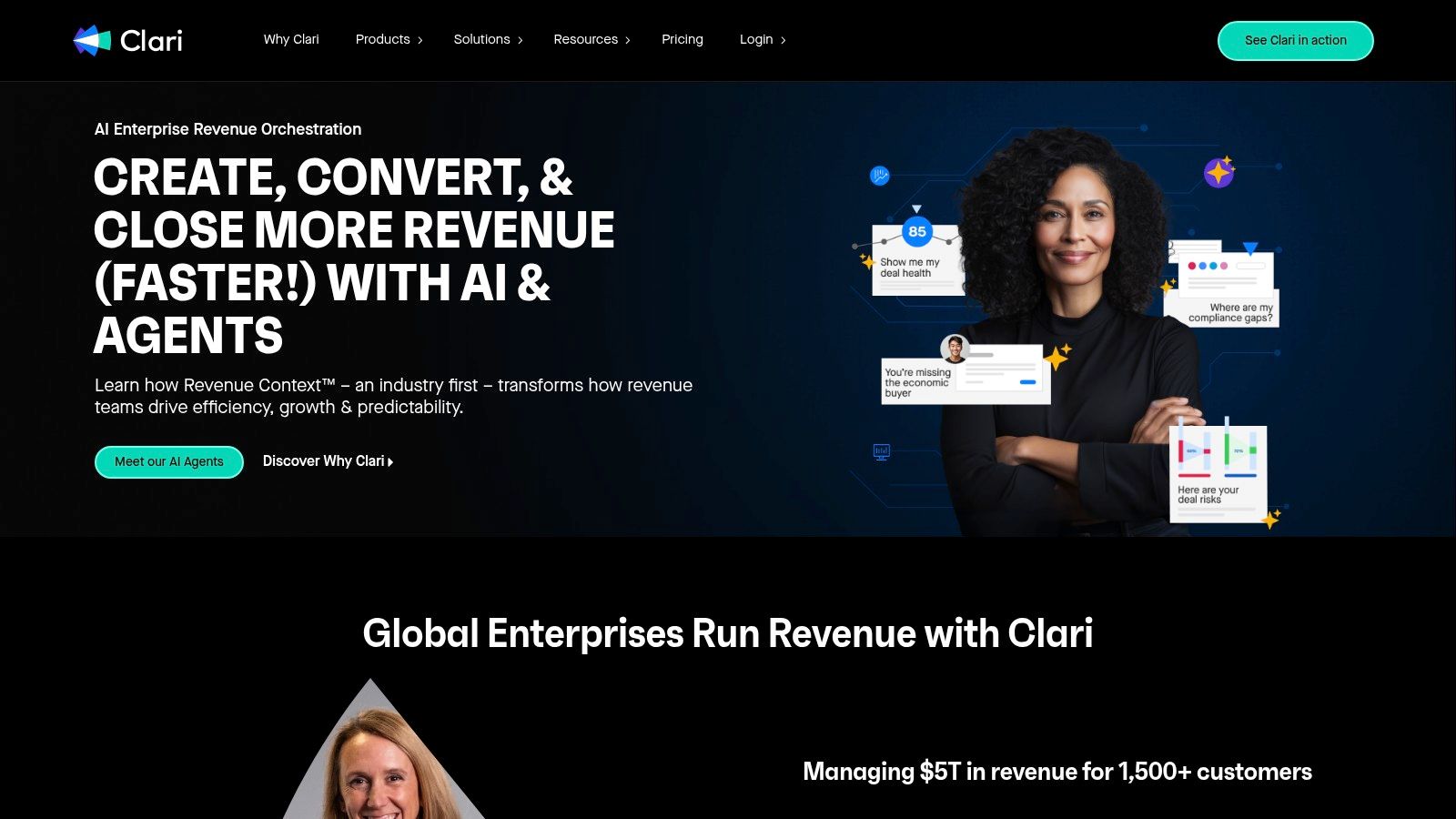
What makes Clari one of the best AI tools for sales is its focus on revenue predictability. It moves teams away from relying on gut feelings and subjective updates from reps. Instead, it provides an objective, AI-driven view of your entire pipeline’s health, making your forecast calls with the board less stressful and far more accurate. It’s about creating a culture of accountability backed by real data.
My Experience & Actionable Tips
I’ve seen sales managers spend half of their Monday chasing reps for pipeline updates. Clari kills that habit instantly. The AI automatically tracks email and calendar activity related to deals, so you see real engagement without ever having to ask, "So, what's happening with that big deal?"
Actionable Tip: Use the Deal Risk Assessment feature to create a weekly "At-Risk Deals" watchlist. Review it in your team meetings to brainstorm concrete next steps for deals the AI has flagged due to low engagement or a stalled sales cycle. This turns a reactive process into a proactive one.
What to NEVER do: Don't assume Clari replaces the need for sales coaching. It provides the "what," but you, the manager, still need to provide the "how." Use Clari’s insights as the starting point for coaching conversations, not the end of them. A red flag from the AI is a perfect opportunity to dig in and help your rep. 🤝
Pros:
- Enhances Forecast Accuracy: Dramatically improves your ability to call your number confidently.
- Provides Comprehensive Insights: Gives a completely unbiased view of pipeline health.
- Integrates with CRMs: Works on top of systems like Salesforce to add a layer of intelligence.
Cons:
- Opaque Pricing: Pricing is not publicly available and requires a custom quote.
- Requires Training: Provides time for the team to adopt it fully and trust the AI's insights over their gut feelings.
Pricing: Clari does not list public pricing on its website. You must contact their sales team to receive a custom quote based on your team's size and specific needs.
Website: https://www.clari.com/
10. People.ai
People.ai is the ultimate enemy of manual data entry and flawed forecasting. Its core mission is to solve one of the most persistent problems in sales: getting accurate activity data into your CRM without turning your Reps into full-time data clerks. It sits in the background, automatically capturing every email, meeting, and contact from your sales team's calendar and inbox, then intelligently maps it all to the correct accounts and opportunities in your CRM.
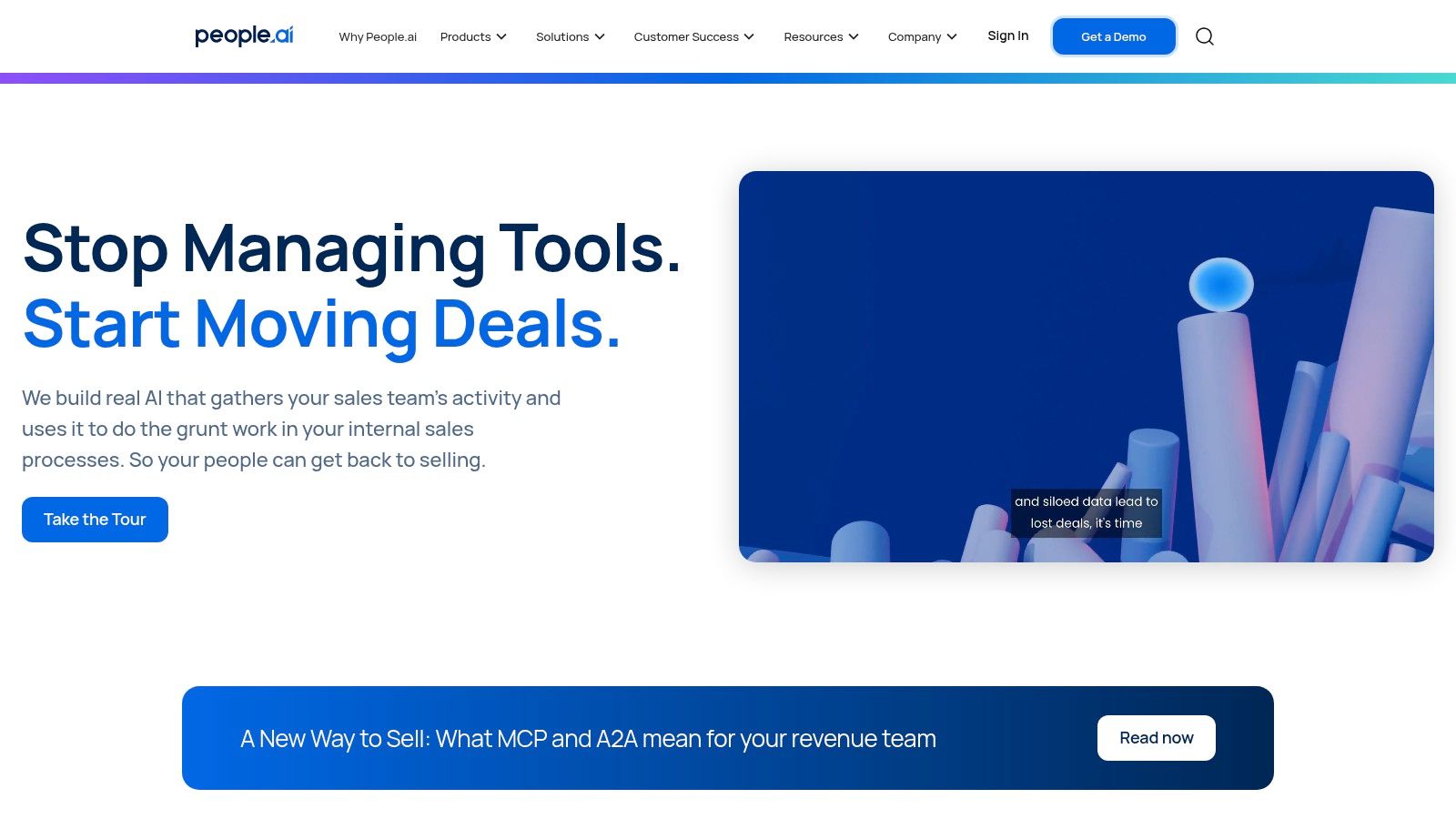
This platform isn't just about saving time; it's about creating a single source of truth for all revenue activity. By analyzing this complete and unbiased dataset, its AI delivers crystal-clear insights into account engagement and provides far more reliable sales forecasts. This makes it one of the best AI tools for sales leaders who are tired of chasing reps for updates and relying on gut feelings to predict the quarter.
My Experience & Actionable Tips
I've seen sales teams transform their forecasting meetings from subjective guessing games to data-driven strategic sessions using People.ai. The biggest win is liberating your top performers from the drudgery of CRM updates, allowing them to focus entirely on selling.
Actionable Tip: Use the Account Engagement Score to identify at-risk renewals or upsell opportunities. If you notice a key account where engagement has dropped off, you can proactively intervene before it becomes a problem. Don't wait for the red flags to appear in your pipeline; let the activity data guide you.
What to NEVER do: Don't assume People.ai will fix a broken sales process. It provides visibility into your process, but it won't invent one for you. If your team isn't engaging with the right personas or accounts, the platform will highlight that fact with painful clarity. Use the data it provides to coach and improve, not just to monitor.
Pros:
- Eliminates Manual Data Entry: Saves the Sales team countless hours, boosting productivity and morale.
- Improves Forecast Accuracy: Bases predictions on real activity data, not just rep sentiment.
- Integrates with Major CRMs: Works seamlessly with platforms like Salesforce, enhancing your existing tech stack.
Cons:
- Effectiveness depends on CRM Adoption: It requires a well-structured CRM to map data effectively.
- Opaque Pricing: Pricing is not publicly available and requires a direct sales consultation.
Pricing: People.ai operates on a custom pricing model. You'll need to contact their sales team for a quote based on your organization's size, specific needs, and the scale of implementation.
Website: https://www.people.ai/
11. Regie.ai
Regie.ai is like giving your sales development team a high-powered AI co-pilot for their entire outbound process. Instead of just writing a single email, it aims to manage the whole sequence, from identifying the right people at target accounts to crafting personalized messages and even prioritizing who to engage with. It’s designed to eliminate the guesswork and manual labor required for building a high-quality pipeline. Think of it as an assembly line for crafting hyper-personalized outreach at scale.
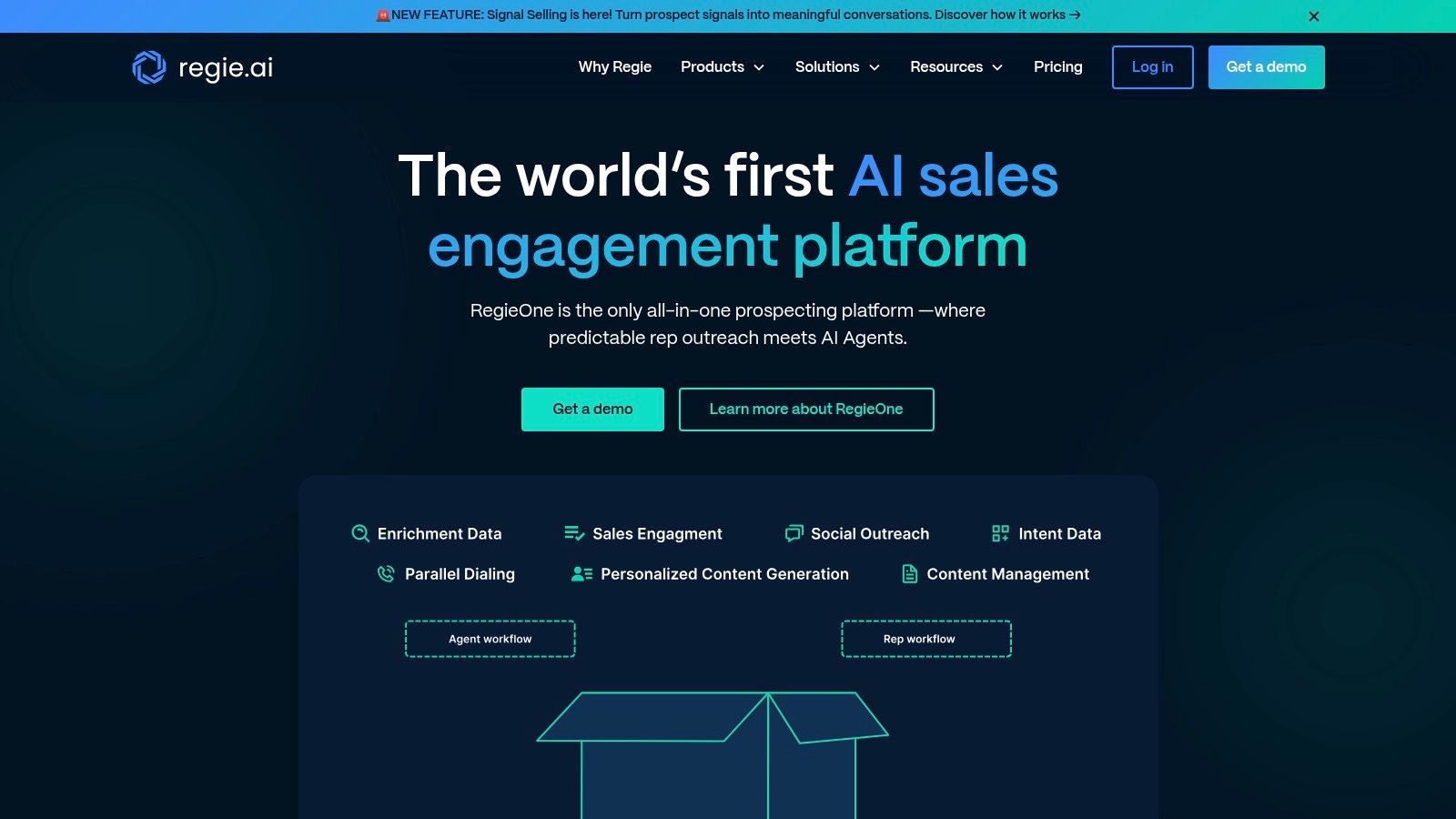
What makes Regie.ai one of the best AI tools for sales is its holistic approach. It doesn't just generate text; it analyzes job postings, case studies, and persona data to tailor messaging that genuinely resonates. It connects content creation directly to audience intelligence, ensuring your team’s efforts are both efficient and effective, moving beyond generic templates to create meaningful conversations.
My Experience & Actionable Tips
I've seen SDR teams spend half their day researching and the other half writing generic emails. Regie.ai collapses that entire workflow. The key is to trust the AI's first draft but always refine it with your human touch.
Actionable Tip: Utilize the Audience Discovery feature to build a specific persona list. Feed it your ideal customer profile, including pain points and goals. The quality of your content generation downstream depends entirely on the quality of the persona you build upstream. A well-defined persona is your secret weapon here.
What to NEVER do: Don't let the AI run on complete autopilot without review. The AI-generated messages are a fantastic starting point, but they can occasionally miss nuance or sound slightly off. A quick human check before launching a campaign prevents embarrassing mistakes and ensures your brand voice remains authentic. Always be the final filter.
Pros:
- Automates the Full Outreach Cycle: It handles everything from list building to multi-touch sequence creation.
- Highly Personalized Messaging: Uses rich data sources to tailor content, improving reply rates.
- Continuous Campaign Optimization: The system learns and adapts to improve performance over time.
Cons:
- Limited Direct Integrations: May require workarounds for CRMs or sales tools beyond its core integrations.
- AI Needs Fine-Tuning: The generated messaging is a powerful head start, but often requires human refinement.
Pricing: Regie.ai offers a free plan for individuals. Paid plans start with the Pro tier at $89/user/month (billed monthly) or $59/user/month (billed annually), which includes core content generation and personalization features. Custom enterprise pricing is also available for larger teams.
Website: https://www.regie.ai/
12. Seamless.AI
Seamless.AI is your AI-powered bloodhound for B2B prospecting. Its core mission is to eliminate the soul-crushing task of manually hunting for contact information. Instead of spending hours on LinkedIn and guessing email formats, your sales team can use its real-time search engine to find verified emails, direct dials, and company insights for nearly anyone. This platform is a godsend for top-of-funnel activities, filling your pipeline with accurate data so your reps can focus on selling, not searching.

What makes it one of the best AI tools for sales is its commitment to real-time verification. It doesn't just pull from a static, aging database; its AI validates contact information on the fly to ensure high deliverability and connect rates. This dramatically reduces bounce rates and wasted time, empowering reps to build targeted lead lists with confidence and speed.
My Experience & Actionable Tips
I’ve seen sales development reps (SDRs) increase their outreach volume by over 30% simply by changing manual prospecting to Seamless.AI. The key is to treat it like a strategic research tool, not just a credit-burning machine. The biggest mistake is aimlessly searching for contacts without a clear ideal customer profile (ICP).
Actionable Tip: Use the "Advanced Search" filters to their full potential. Combine filters like company size, industry, revenue, and specific technologies used. This allows you to build hyper-targeted lists of accounts that are a perfect fit for your product, rather than just grabbing random contacts.
What to NEVER do: Don't rely solely on job titles. Use keyword searches within job titles to find decision-makers who might not have a standard C-suite title but hold significant purchasing power. Think "Head of Growth" or "Demand Generation Lead" instead of just "CMO."
Pros:
- Automates prospecting and saves countless hours of manual research.
- Provides highly accurate and verified contact information, improving connect rates.
- Integrates smoothly with major CRM and sales engagement platforms.
Cons:
- Pricing isn't transparently listed on the website, requiring a demo or sales call.
- The interface would take some getting used to before you can maximize its powerful features.
Pricing: Seamless.AI does not list its pricing publicly. You need to contact their sales team for a custom quote based on your team size and needs. They typically operate on a credit-based system.
Website: https://www.seamless.ai/
Top 12 Best AI Sales Tools Feature Comparison
Stop Selling Harder, Start Selling Smarter
We've just navigated through a powerful arsenal of the best AI tools for sales, from comprehensive platforms like Salesforce Sales Cloud to specialized powerhouses like Gong.io for conversation intelligence and Gojiberry AI for intent data. The sheer volume of options can feel overwhelming, but that feeling is a signal. It’s a sign that the ground beneath the entire sales profession has shifted permanently.
Look, I've been there. I can recall the grind of manual prospecting, spending entire days digging through LinkedIn, guessing at email addresses, and then sending out hundreds of cold emails that felt like shouting into the void. The result? A trickle of lukewarm responses and a pipeline that gave me constant anxiety. It wasn't just inefficient; it was demoralizing.
My biggest mistake was believing that "working harder" would solve everything. Increasing calls and emails lead to burnout, not success.
The core takeaway from this isn't about adopting a new piece of software, but a fundamental mindset shift. You need to move from being a manual laborer in the Sales mine to becoming a strategic architect of your pipeline. AI is the tool that enables this transformation. It automates the drudgery, illuminates the path to your best customers, and frees you up to do what humans do best: build relationships, understand nuanced problems, and close deals.
Your Action Plan: How to Choose Your AI Sales Stack
Feeling motivated? Great. Now, let's turn that energy into a concrete plan. Don't just randomly sign up for free trials. That's a recipe for chaos. Instead, follow this strategic approach.
Step 1: Audit Your Current Sales Process (The Honest Truth)
Before you even look at a pricing page, map out your current sales funnel. Where are the biggest leaks?
- Top of Funnel: Are you struggling to find enough leads? Is your lead quality abysmal? Tools like Apollo.io, ZoomInfo, and Seamless.AI are built to solve this.
- Mid-Funnel: Are your demos falling flat? Do you lose prospects after the first call? This is where Gong.io or Clari can shine by analyzing what happens in your sales conversations.
- Closing: Are deals stalling out in the final stages? Is your follow-up inconsistent? A CRM with AI, such as Salesforce or an engagement platform like Outreach, can keep the momentum.
Step 2: Define Your "One Big Thing"
What is the single biggest bottleneck that, if solved, would radically change your results? Don't try to fix everything at once. Is it identifying accounts that are actively looking for a solution right now? Then you need a buyer intent tool. Is it coaching your reps to be better on calls? You need conversation intelligence. Pick one primary problem to solve first.
For so many teams I talk to, the problem isn't their pitch or their product. It's that they are talking to the wrong people at the wrong time. They're trying to sell a winter coat in the middle of summer. This is where tools that identify buying intent, like Gojiberry AI, are not just a "nice to have," they are a competitive necessity.
Step 3: Pilot, Measure, and Scale
Once you've identified a tool for your "one big thing," don't roll it out to the entire team. Select a small pilot group of 2-3 reps.
- DO: Define clear success metrics before you start. Is it "number of qualified meetings booked" or "shortened sales cycle"?
- NEVER: Judge the tool on "how the reps feel about it" without hard data. Feelings are fickle; pipeline is a fact.
- Actionable Tip: Run the pilot for at least one full sales cycle. Give the tool a real chance to prove its ROI before making a final decision.
"Gut feeling" sales are outdated. Your competitors are already using data to find your next customer before you even know they exist. The question now is not whether you should integrate AI into your sales process, but rather how quickly you can integrate the best AI tools for sales to accelerate your growth. You can either learn how to play chess with artificial intelligence or keep playing checkers.
Are you ready to put an end to your speculation and start contacting prospective clients who are actively looking for a product like yours? Using GojiberryAI's AI to identify buyer intent signals across the web, you can engage with the right accounts at the exact moment they are ready to purchase. For more information and to obtain genuine, warm leads for your pipeline, visit GojiberryAI today.
Frequently Asked Questions
H3: How do I get my Sales team to adopt a new AI tool?
This is the million-dollar question! My biggest mistake was dropping a new tool on my team and expecting them to love it. It created resentment. What works? First, involve them in the selection process. Pilot the tool with your most tech-savvy rep and a skeptic. Second, frame it as a tool to eliminate their most hated tasks (manual data entry) and help them hit their bonus. Third, lead by example. As a manager, you need to understand the tool and utilize its insights in your 1-on-1s. It shouldn't be optional.
H3: Are these AI tools going to replace my sales job?
No, but a salesperson using AI will replace a salesperson who isn't. Think of these tools as a co-pilot, not the pilot. AI isn't good at building genuine human rapport, navigating complex company politics, and showing empathy for a customer's unique problem. Your job is to leverage AI to handle 80% of grunt work so you can excel at the 20% that requires a human touch. That's how you become invaluable.
H3: I'm a solo founder/small startup. Which tool gives the best ROI for my buck?
I've been in your shoes, and budget is everything. My advice is to find a tool that solves your most immediate pain point without breaking the bank. For pure top-of-funnel lead generation and data, Apollo.io offers an incredible amount of value on its free and low-cost plans. If your biggest problem is finding warm leads so you don't waste time on scrapping databases, investing in a buyer intent tool like Gojiberry AI can have a massive ROI because it directly allows you to find high intent prospects, which is priceless when you're a small team.
H3: Can AI help with writing sales emails that don't sound like a robot?
Absolutely, but with a huge caveat. Tools like Regie.ai can generate fantastic, personalized drafts based on prospect data. NEVER copy, paste, and send without reading and editing. The AI gives you a 90% solution. Your job is to add the final 10% of humanity, wit, and personal touch. Use it as a writing assistant, not a ghostwriter. I once saw a rep send an AI-generated email that referenced the wrong company, a quick human proofread would have saved him the embarrassment.
More High-Intent Leads = Your New Growth Engine.
Start Now and Get New High Intent Leads DeliveredStraight to Slack or Your Inbox.







